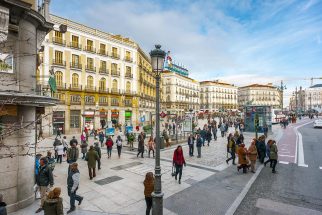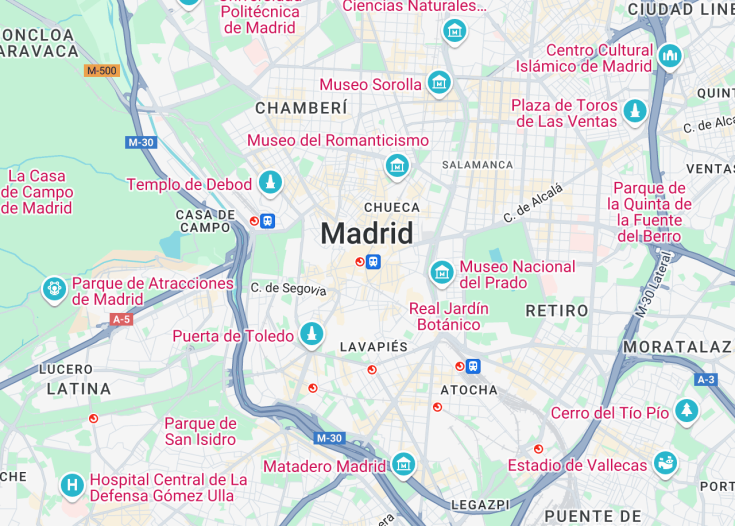Welcome to the beautiful city of Madrid, a captivating destination filled with rich history, vibrant culture, and breathtaking architecture. Known for its lively atmosphere and warm hospitality, Madrid offers a truly remarkable tourist experience.
If you want to fully immerse yourself in the wonders of Madrid, I recommend staying for at least a week. This will give you ample time to explore the city’s iconic landmarks, indulge in its culinary delights, and soak up its vibrant energy.
Before embarking on your Madrid adventure, here’s a helpful tip: make sure to wear comfortable shoes. Madrid is a city best explored on foot, allowing you to discover hidden gems tucked away in its charming streets and plazas.
Top things to do & see in Madrid
Select the following sights and activities to discover best tickets and tours available in Madrid.
Madrid: The Heart of Spain
| Country | Spain |
| Time in Madrid | GMT+1 |
| Language spoken | Spanish |
| Population | 3,266,126 (source: Instituto Nacional de Estadística, 2022) |
| Currency | Euro (€, EUR) |
| Airports |
|
Madrid, the vibrant capital of Spain, is pulsating with rich history and modern innovation. Located at the heart of the Iberian Peninsula, Madrid’s roots can be traced back to the 9th century with the establishment of the Alcazar, a fortress that became the kingdom’s royal palace. Through the ages, Madrid has served as the central stage for many pivotal events in Spanish and European history, including the Spanish War of Independence and the artistic renaissance of the Spanish Golden Age.
Today, Madrid continues to be a pivotal cultural and political center. The city is adorned with grand boulevards, expansive, manicured parks such as the Retiro, and landmarks that include the iconic Royal Palace and the Prado Museum, housing works by Spanish masters like Velázquez and Goya. Madrid’s cuisine and nightlife add vibrant chapters to the city’s life, with tapas bars, fusion restaurants, and jazz lounges animating its vivid social landscape. The city’s love for football is palpable, encapsulated in two world-famous clubs, Real Madrid and Atletico de Madrid, representing the city’s pulse.
More than just a cultural beacon, Madrid serves as a central hub for international business and diplomacy. It is home to numerous multinational companies, and a pivotal point of connectivity in Europe’s transport network. These facets collate to depict a city that’s not only steeped in tradition but also dynamically progressive.
Where is Madrid?
Madrid sits at the geographical center of Spain, approximately 646 meters above sea level, making it one of Europe’s highest capitals.
Distances:
| Route | Distance by Car | Time by Car |
|---|---|---|
| Barcelona to Madrid | 386 miles | 5h 45min |
| Valencia to Madrid | 222 miles | 3h 30min |
| Seville to Madrid | 334 miles | 5h 15min |
What is Madrid famous for?
Madrid is renowned for its historic center, art-rich museums like the Prado, and vibrant cultural life, including spirited fiestas and bustling tapas bars.
History
Madrid, as the capital of Spain, boasts a fascinating history that spans several centuries, evolving from a small Moorish fort to the bustling metropolis we see today.
9th-11th century: The Moorish Foundation
The earliest historical records of Madrid trace back to the 9th century when it was a small fortress (Mayrit) built by the Moors. This strategic outpost was erected on the Manzanares River to fortify the Moorish kingdom against the advancing Christian kingdoms from the north. The town provided a crucial defensive point during the Reconquista, the centuries-long battle by Christian states to reclaim territory from the Moors.
1561: Establishment as the Capital
In 1561, King Philip II chose Madrid as the capital of his vast empire, elevating its status significantly. This choice was strategic due to Madrid’s central location in the Iberian Peninsula. Under Philip’s reign, Madrid saw the construction of palaces, public squares, and churches, which laid the foundation for its transformation into a significant European capital.
19th century: Wars and Changes
Throughout the 19th century, Madrid faced numerous challenges, including the Peninsular War against Napoleonic France and the Spanish War of Independence. These conflicts led to substantial destruction and economic hardship. However, the 19th century also marked Madrid’s urban expansion and industrial growth, setting the stage for further developments in the 20th century.
20th century: Civil War and Dictatorship
The Spanish Civil War (1936-1939) had a profound impact on Madrid. The city suffered significant damage during the conflict as it was a key stronghold of the Republican forces until falling to Franco’s Nationalists. After the civil war, during Franco’s dictatorship, Madrid became a symbol of the Nationalist victory and underwent numerous developmental projects, reshaping its cultural and political landscape.
21st century: Modern Developments
Into the 21st century, Madrid has continued to expand and modernize while preserving its rich historical heritage. The city has become a significant hub for international business, culture, and education in Europe. Major infrastructure projects and cultural initiatives have further enhanced Madrid’s global appeal and the quality of life for its residents.
Visit Madrid
What to see and do in Madrid
Madrid, the vibrant capital of Spain, offers a unique blend of historical and modern attractions that cater to all interests.
- Explore the Prado Museum, home to one of the finest art collections in the world.
- Stroll through the Retiro Park, a massive green oasis in the city center.
- Visit the Royal Palace, the official residence of the Spanish royal family.
- Experience the lively atmosphere of the Puerta del Sol and Plaza Mayor.
- Indulge in traditional Spanish cuisine at the numerous tapas bars and restaurants.
Annual Events in Madrid
Madrid hosts several exciting events throughout the year which reflect its rich culture and dynamic atmosphere:
- Madrid Carnival (February-March): A vibrant celebration with parades, music, and costumes.
- San Isidro (May): Honoring Madrid’s patron saint with traditional music, dance, and bullfights.
- The Madrid Jazz Festival (November): Showcasing a wide range of jazz performances.
- Christmas Markets (December): Enlivening the city with festive decorations and treats.
Best time to visit Madrid
The ideal times to visit Madrid are during the spring (March to May) and autumn (September to November). During these periods, the weather is comfortably mild, and the city is less crowded, providing a pleasant atmosphere for exploring its many attractions.
Is Madrid worth visiting?
Madrid indeed offers a compelling mix of cultural richness, historical depth, and modern comforts, making it a worthwhile destination for any traveler. Its world-renowned museums, lush parks, and vibrant nightlife are significant draws. However, it is essential to consider the hot summers and bustling crowds, which might be a deterrent for some visitors. Overall, Madrid provides an enriching experience that balances grandeur with an inviting local charm.












